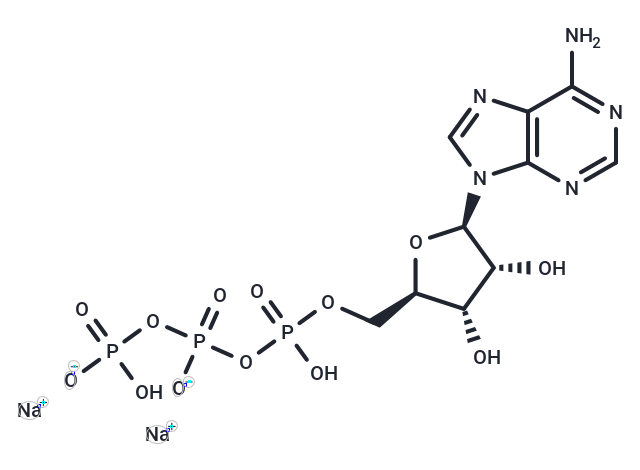Shopping Cart
- Remove All
 Your shopping cart is currently empty
Your shopping cart is currently empty


| Pack Size | Price | Availability | Quantity |
|---|---|---|---|
| 1 g | $50 | In Stock |
| Description | ATP disodium salt (Adenosine-Triphosphate) is a P2 purinoceptor agonist. |
| In vitro | ATP release and autocrine feedback through P2Y2 and A3 receptors provide signal amplification, controlling gradient sensing and migration of neutrophils. [1] ATP results in production of reactive oxygen species (ROS), which stimulates the phosphatidylinositol 3-kinase (PI3K) pathway and subsequent Akt and ERK1/2 activation. ATP-dependent ROS production and PI3K activation also stimulate transcription of genes required for an oxidative stress response. ATP-mediated ROS-dependent PI3K is required for activation of caspase-1 and secretion of IL-1beta and IL-18. [2] ATP potently stimulates TNF-alpha release, resulting from TNF-alpha mRNA expression in rat cultured brain microglia. ATP-induced TNF-alpha release is Ca(2+)-dependent, and a sustained Ca(2+) influx correlated with the TNF-alpha release in ATP-stimulated microglia. ATP-induced TNF-alpha release is inhibited by PD 098059, an inhibitor of extracellular signal-regulated protein kinase (ERK) kinase 1 (MEK1), which activates ERK, and also by SB 203580, an inhibitor of p38 mitogen-activated protein kinase. ATP rapidly activates both ERK and p38 even in the absence of extracellular Ca(2+). [3] ATP-induced cytotoxicity is mediated by classical alterations of apoptosis, including membrane blebbing, nuclear condensation, and DNA fragmentation. ATP but not other nucleotides lead to the potent and selective activation of NF-κB in microglial cells through a P2Z receptor-mediated pathway. [4] |
| In vivo | ATP regulates microglial branch dynamics in the intact mice brain, and its release from the damaged tissue and surrounding astrocytes mediates a rapid microglial response towards injury. [5] |
| Alias | Adenosine 5'-triphosphate disodium salt, ATP, ATP disodium, Adetide, Adenosine-Triphosphate, Disodium adenosine triphosphate |
| Molecular Weight | 551.14 |
| Formula | C10H14N5O13P3·2Na |
| Cas No. | 987-65-5 |
| Storage | Powder: -20°C for 3 years | In solvent: -80°C for 1 year | Shipping with blue ice. | ||||||||||||||||||||
| Solubility Information | DMSO: Insoluble H2O: 10 mM | ||||||||||||||||||||
Solution Preparation Table | |||||||||||||||||||||
H2O
| |||||||||||||||||||||

Copyright © 2015-2024 TargetMol Chemicals Inc. All Rights Reserved.